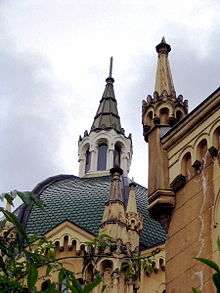Karel Pařík
| Karel Pařík | |
|---|---|
.jpg) | |
| Born |
4 July 1857 Veliš u Jičína, Austrian Empire |
| Died |
16 June 1942 (aged 84) Sarajevo, Independent State of Croatia |
| Nationality | Czech |
| Occupation | Architect |
| Buildings |
National Museum of Bosnia and Herzegovina Sarajevo Synagogue The Evangelical Church Municipal Hall Sharia School Hotel Europe (Sarajevo) |

Karel Pařík (4 July 1857 – 16 June 1942) was a Czech-born architect of Austro-Hungarian citizenship who spent most of his life in Sarajevo where he designed over seventy major buildings.
This Czech native, born near Jičín in 1857, moved to Sarajevo at the age of 26, after the Austro-Hungarian ascension of Bosnia and Herzegovina. He designed around 150 buildings in Bosnia, 70 of them being in Sarajevo. Today they house important Sarajevo institutions such as: National Museum of Bosnia and Herzegovina, Sarajevo National Theatre, Sharia School, Sarajevo Synagogue, as well as house of government and schools.[1]
He fought for maintaining historical parts of Sarajevo and proposed construction of new parts of the city away from the old town. Karel Pařík placed his personal mark and made great contributions to the urbanization of Sarajevo and Bosnia and Herzegovina during the Austro-Hungarian Empire.[2] He is buried in Sarajevo, Bosnia and Herzegovina.
Significant buildings
- Hotel Europe - Karel Pařík also designed one of the Sarajevo's first modern hotels, this being Hotel Evropa. It was constructed in 1882 and opened December 12, 1882. For 110 years this was the most spacious hotel in Sarajevo, from its opening until its destruction August 1, 1992. Many poets, painters, and artists of all types and politician stayed in this hotel during the Austro-Hungarian Empire, Kingdom of Yugoslavia, and later in the time of the Socialist Federal Republic of Yugoslavia. The hotel was reconstructed and officially re-opened on December 12, 2008 on its 126th birthday.
- Sharia School (Faculty of Islamic Studies) - Among Pařík’s first projects was the Sarajevo Sharia School. It was constructed in 1887 in a rich pseudo-Moorish decorative style with elements and details collected from various regional Islamic art schools. The Museum of the City of Sarajevo was opened in the building in 1949 which contained archaeological, historical, ethnographic and art collections. Today this building is used as the Faculty of Islamic Sciences.
- National Museum of Bosnia and Herzegovina - The National Museum building is one of the most significant works of Karel Pařík in Sarajevo. The Museum was founded in 1885 and was open to the public March 1, 1888. The building consists of 4 pavilions joined by a terrace and a botanical garden in the center. The whole building of the National Museum was constructed in the spirit of the Neo-Renaissance and work on the building lasted until 1913.
- National and University Library of Bosnia and Herzegovina (Vijecnica) - In 1891, Pařík worked on another major building in the pseudo-Moorish style – The Municipal Hall. Pařík did not want to accept the request of governor Benjamin Kallay to make it very large and therefore Pařík's proposal was rejected. The construction was turned over to Alexander Wittek who was inspired by used the Mosque of Kemal II in Cairo. After Wittek’s death the construction was completed under Čiril Iveković's supervision in 1896. However, the building was built in the style originally conceived by Karel Pařík. During the period of Yugoslavia this building functioned as the National and University Library of Bosnia and Herzegovina. In the Bosnian war of the 1990s the building was destroyed and reconstruction was completed in 2014.
- Landesbank - Originally this building housed the Grand Hotel (Union Hotel). After World War Two the hotel was known as Landesbank (Zemaljska banka – National Bank), then as a Service of Social Accounting, and today it houses the Department of payment processing. The building was erected in 1893 and the hotel opened in 1895. It was designed by Karel Pařík and his colleague Josip Vancaš. The façade was built in the spirit of early Renaissance and in 1946 Eternal Flame monument was added in front of its main entrance. The flame serves as a memorial monument for the Liberators of Sarajevo, and victim of fascism, who have fallen during the World War II.
- Academy of Fine Arts - Today's Academy of Fine Arts building originally housed the Evangelical Church. It was the only Evangelical church built during the Austro-Hungarian government and it was constructed in 1899. Pařík's design was inspired by the Romanic-Byzantine style. Additional wings of the building were completed in 1911.
- Ashkenazi Synagogue - During the Austro-Hungarian condominium Sephardic and Ashkenazy communities lived in Sarajevo. The Ashkenazy community came to Sarajevo after 1878 and began constructing a synagogue in 1901. The form of the temple is bejeweled with sharp angled domes over large “drums” and covered with pseudo-Moorish decorations. During the construction changes were made by Pařík and the building was completed in 1902.
Among many other Karel Pařík's works, a couple that particularly stand out are also the Sarajevo Law School building, St.Joseph Church, National Bank, Marijin Dvor and many other buildings in Sarajevo.[3]
Gallery
- Sarajevo Law School building
- Entrance to the Sarajevo Law School and Rectorate of the University of Sarajevo
- Hotel Europe (1882)
- Faculty of Islamic Studies (1887)
_(14595116167).jpg) Faculty of Islamic Studies in 1897
Faculty of Islamic Studies in 1897- National Museum (1888)
 National Museum in 1935
National Museum in 1935
 Landesbank building (1893)
Landesbank building (1893) Academy of Fine Arts, originally Evangelical Church (1899)
Academy of Fine Arts, originally Evangelical Church (1899) Dome and towers on the Academy of Fine Arts
Dome and towers on the Academy of Fine Arts- Ashkenazi Synagogue (1902)

 Saint Joseph Catholic Church (Marijn Dvor)
Saint Joseph Catholic Church (Marijn Dvor)